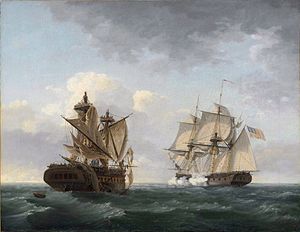Lively class frigate

HMS Macedonian (left) of the Lively class - in action against USS United States
|
|
| Class overview | |
|---|---|
| Operators: |
|
| Completed: | 16 |
| General characteristics | |
| Type: | Fifth-rate frigate |
| Tons burthen: | 1,071 51/94 (as designed) |
| Length: | 154 ft (47 m) |
| Beam: | 39 ft 5 in (12.01 m) |
| Draught: | 13 ft 6 in (4.11 m) |
| Propulsion: | Sail |
| Sail plan: | Full rigged ship |
| Complement: | 284 (later raised to 300, then in 1813 to 320). |
| Armament: |
|
The Lively class were a successful class of sixteen British Royal Navy 38-gun sailing frigates.
The Lively class were a series of sixteen ships built to a 1799 design by Sir William Rule, which served in the Royal Navy during the Napoleonic Wars. The prototype and name ship of the class was HMS Lively of 1804. In contemporary usage the class was referred to as the 'Repeat Lively class'. As such the prototype ship was not considered to be part of the class at the time.
They were considered the most successful British frigate design of the period, much prized by the Navy Board; after the prototype was launched in 1804 (by which time four more frigates had already been ordered to the same design), a further eleven sister-ships were ordered to her design, although this was slightly modified (in 1805) to have the gangways between forecastle and quarterdeck more integrated into the upperworks, a step towards the final enclosure of the waist. This was reinforced in 1809 by the abandonment of breastworks at the break of the quarterdeck and forecastle and in 1810 by the narrowing of the waist by the addition of gratings inboard of the gangways. At the same date, 'top riders', angled reinforcing timbers for the upperworks, were discontinued.
The United States Navy ordered a frigate to the design of the captured HMS Macedonian in 1832, which was launched in 1836 as USS Macedonian.
The captain's reports on the performance of this class were remarkable for their absence of serious criticism. The vessels of the class were fast, recording 13kts large and 10-11kts close-hauled, weatherly and manoeuvrable. They were excellent heavy-weather ships, perfectly able to cope with a "head sea." They stowed their provisions well; they were capable of stowing provisions and freshwater for up to six months of cruising. Indeed "riding light," after a substantial proportion of fresh water and provisions had been consumed, affected their sailing qualities adversely, so that most captains filled any emptied freshwater stowage capacity with seawater.
...
Wikipedia
